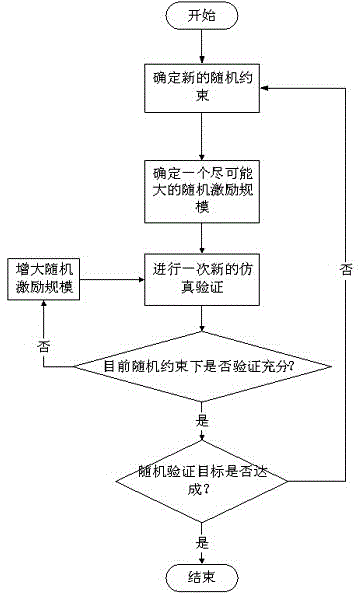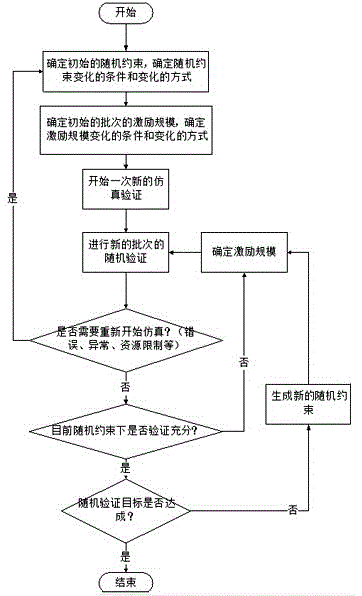Batched random mechanism for chip random verification
A random verification and mechanism technology, which is applied in special data processing applications, instruments, electrical digital data processing, etc., can solve the problems of unreachable scenes and decreased scene diversity, and achieve the effect of accelerating verification convergence
- Summary
- Abstract
- Description
- Claims
- Application Information
AI Technical Summary
Problems solved by technology
Method used
Image
Examples
Embodiment 1
[0025] A batch-based random mechanism for chip random verification. Considering the possible impact of the number of random incentives on verification efficiency under specific random constraints in chip random verification, the efficiency of random verification in ultra-large-scale chip verification will vary with the As the simulation time increases, it decreases exponentially, and a single random verification is divided into several batches of verification serial execution, each batch of verification contains a certain number of incentives, and the efficiency evaluation of the current random verification is provided between different batches of verification And the control mechanism, so that the random constraint and the corresponding random incentive scale can be modified according to the change of verification efficiency. That is to say, the random verification will run under the specific random constraints before the verification efficiency decreases to a certain level, o...
Embodiment 2
[0028] Such as figure 2 As shown, on the basis of Embodiment 1, the implementation process of the random mechanism described in this embodiment is as follows:
[0029] 1) Quantify the generation constraints of random incentives; ensure that the modification of random constraints can be automatically completed through programs or scripts;
[0030] 2) Random incentives are generated in batches; generating random incentives in batches is different from generating all random incentives at the same time or with the same set of random constraints. Only a part (batch) of incentives is generated each time according to the current random constraints; each batch of The number of incentives can be fixed or not; the advantage of a fixed number of incentives is that it is easy to control, and if some appropriate algorithms are used to control the number of incentives between different batches, random verification of batches can be realized more flexibly. Which one is used? The method nee...
Embodiment 3
[0035] On the basis of Embodiment 2, the evaluation standard of the verification efficiency described in this embodiment: evaluate through defined coverage (code coverage or function point coverage).
PUM
 Login to View More
Login to View More Abstract
Description
Claims
Application Information
 Login to View More
Login to View More - R&D
- Intellectual Property
- Life Sciences
- Materials
- Tech Scout
- Unparalleled Data Quality
- Higher Quality Content
- 60% Fewer Hallucinations
Browse by: Latest US Patents, China's latest patents, Technical Efficacy Thesaurus, Application Domain, Technology Topic, Popular Technical Reports.
© 2025 PatSnap. All rights reserved.Legal|Privacy policy|Modern Slavery Act Transparency Statement|Sitemap|About US| Contact US: help@patsnap.com


